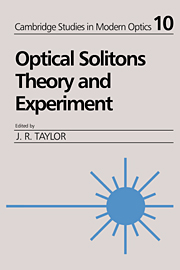Book contents
- Frontmatter
- Contents
- List of contributors
- Preface
- 1 Optical solitons in fibers: theoretical review
- 2 Solitons in optical fibers: an experimental account
- 3 All-optical long-distance soliton-based transmission systems
- 4 Non-linear propagation effects in optical fibres: numerical studies
- 5 Soliton–soliton interactions
- 6 Soliton amplification in erbium-doped fiber amplifiers and its application to soliton communication
- 7 Non-linear transformation of laser radiation and generation of Raman solitons in optical fibers
- 8 Generation and compression of femtosecond solitons in optical fibers
- 9 Optical fiber solitons in the presence of higher-order dispersion and birefringence
- 10 Dark optical solitons
- 11 Soliton-Raman effects
- Index
3 - All-optical long-distance soliton-based transmission systems
Published online by Cambridge University Press: 21 October 2009
- Frontmatter
- Contents
- List of contributors
- Preface
- 1 Optical solitons in fibers: theoretical review
- 2 Solitons in optical fibers: an experimental account
- 3 All-optical long-distance soliton-based transmission systems
- 4 Non-linear propagation effects in optical fibres: numerical studies
- 5 Soliton–soliton interactions
- 6 Soliton amplification in erbium-doped fiber amplifiers and its application to soliton communication
- 7 Non-linear transformation of laser radiation and generation of Raman solitons in optical fibers
- 8 Generation and compression of femtosecond solitons in optical fibers
- 9 Optical fiber solitons in the presence of higher-order dispersion and birefringence
- 10 Dark optical solitons
- 11 Soliton-Raman effects
- Index
Summary
Introduction
The theoretical studies of long-distance soliton transmission in optical fibres with periodic Raman gain were outlined in Chapter 2 ‘Solitons in Optical Fibres: An Experimental Account’ by L. F. Mollenauer. From this work, it was anticipated that the overall information rates made possible by the all-optical nature of the system were potentially orders of magnitude greater than in conventional communication systems. Rate–length products were predicted to be as high as approximately 30000 GHz · km for a single wavelength channel. In the following sections we will describe the first set of experiments designed to explore the fundamentals of such long-distance repeaterless soliton transmissions.
Experimental investigation of long-distance soliton transmission
In the following experiments, a train of soliton pulses was injected into a closed loop of fibre, the length of which corresponded to one amplification period in a real communication system. The pulses propagated around the loop many times until the net required fibre pathlength had been reached (Mollenauer and Smith, 1988). The experimental configuration is shown schematically in Figure 3.1. A 41.7 km length (L) of low-loss (0.22 dB/km at 1.6 μm) standard telecommunications single-mode fibre was closed on itself with a wavelength selective directional coupler (an all-fibre Mach–Zehnder (FMZ) interferometer). The interferometer allowed efficient coupling of the bidirectional pump waves at approximately 1.5 μm (provided by the 3 dB coupler at the pump input) into the loop. At the same time, the signals at approximately 1.6 μm (50 ps sech2 intensity profile pulses at a 100 MHz repetition rate from a synchronously mode-locked NaCl:OH– colour centre laser) were efficiently recirculated (<5% coupled out).
- Type
- Chapter
- Information
- Optical SolitonsTheory and Experiment, pp. 61 - 72Publisher: Cambridge University PressPrint publication year: 1992



